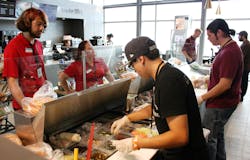As airports continue to step up when it comes to concessions, the industry is seeing growth in bringing popular local concepts from the street to the terminal. These outlets have become a way for airports to further create a sense of place for both local passengers and those who may not have a chance to visit a city.
Why is it important for airports to offer locally based food, beverage and retail concepts? Because consumers are demanding it, said trends expert Daniel Levine, a director at the Avant-Guide Institute consultancy.
“There is a strong trend at the moment toward consumers wanting things that are made locally, that feel more healthful, unique and special,” said Levine. “And because trends don't operate in a vacuum, we are expecting to find these offerings in airport environments as well as downtown shopping centers.”
Airport retailers can raise profits by raising the bar on what customers perceive as local and unique, said Levine. “As shopping venues, airports are in a special position to trade off their very real position as gateways into and out of distinctive local environments,” he noted. “It's not news that airport retailers can do big business with place-name-logo products, but from a trends perspective, we would encourage businesses to up the ante with the most unique local gifts they can find.”
San Francisco International Airport has won awards for its concessions program, including ACI-NA’s Richard A. Griesbach Award of Excellence in 2013. Cheryl Nashir, the airport’s director of revenue development and management, said there are two reasons why having local concepts in the concessions mix are important.
“One, we believe it’s what customers now want to see in our airport. They want to know that they’re in San Francisco,” she said. “Two, our city has a famous and fantastic culinary tradition. We also have a strong commitment to local businesses, and want to work with as many of them as possible.”
Steve Baker is the deputy vice president for customer and concessions development at Metropolitan Washington Airports Authority (MWAA), which manages Ronald Reagan Washington National and Washington Dulles International airports.
“When someone shows you a photo, the first thing you look for is yourself. If we are the airport of the nation’s capital, it’s only natural that we want to reflect ourselves,” he said.
From a business perspective, MWAA wants customers to know that the airports not only represent the capital, but the United States as they transfer to other cities, said Baker. “So it’s important that we reflected the D.C. area at National and the U.S. at Dulles,” he said.
Jim Halbrook is the public information and marketing manager at Austin-Bergstrom International Airport in Texas, where “Keep Austin Weird” is the city’s slogan. “For us, it’s all about a sense a place and representing the community that you serve,” he stated. “Austin is a great and unique destination. It’s an O&D airport and the gateway to the city, so it’s important that passengers can see, hear and taste Austin in the terminal.”
For Tiffany Green, managing deputy commissioner of revenue for the Chicago Department of Aviation (CDA), her two airports -- O’Hare and Midway -- offer the first impressions of the city. “Fifty percent of our passengers never leave the airport, so we want them to reimagine their journey and have memorable experiences in the airport that reflect Chicago,” she said.
Chicago has 77 neighborhoods that are home to diverse cuisines, said Green. “And we want passengers to have a taste of our cuisine and hopefully entice them to come back as tourists,” she said. “Plus local concepts are important to our bottom line because they are well received and bring in money.”
For example, the Wolfgang Puck restaurant in O’Hare’s Terminal 3 was closed, said Green. “It re-opened as Publican Tavern in July 2016 and brought in locally sourced food and beverages,” she said. “In March, Publican Tavern was voted as the best airport restaurant/bar for atmosphere in USA Today’s Travel 10 Best Readers’ Choice Awards. Sales at Publican are up by 31 percent over the previous concept.”
When it comes to airport concessions, it’s all about getting the right balance of local and national concepts that passengers will enjoy. MWAA and CDA have the challenge of doing it at two different airports.
MWAA’s Baker says he looks at it by concept and operator. “If you look at National and Dulles, around 45 percent of our concessions are local to Maryland, Virginia and D.C.,” he said. “We’ve had concepts like Five Guys that grew from a local restaurant to a national one. & Pizza is another concept that’s growing like gangbusters.”
But it all kicked off with the pursuit of Ben’s Chili Bowl, an iconic D.C. restaurant in the U Street neighborhood. “I began conversations with them even before President Obama was elected in 2008. I had come from Atlanta and was looking to create a sense of place, and you can only do that with iconic brands,” he recalled. “At the time, Ben’s had just opened in the Washington Nationals stadium and they weren’t sure they were ready to expand further.”
The mix of local versus national concepts at O’Hare and Midway is different, said Green. “Midway is more of a local airport where approximately 50 percent are local brands and that has definitely been proven to be successful there,” she said.
O’Hare is an international airport with more international passengers flowing through, said Green. “So you will see fewer local brands there,” she said. “Because of the type of passengers we have going through O’Hare, we have to make sure that we provide passengers with recognizable brands and showcase local brands.”
Some of the local brands in O’Hare include Sarah’s Candies, Vosges Haut-Chocolat, Garrett Popcorn Shops and Argo Tea, said Green. “CDA partners with small businesses like these to help them become successful.”
At San Francisco International, 87 percent of the airport’s food and beverage concepts are local, said Nashir. Some of those concepts include 24th & Mission Taco House, Boudin's Bakery and Café, Lark Street Grill and Three Twins Ice Cream.
Austin-Bergstrom has 22 food and beverage vendors, said Halbrook. “Of that, we only have two that aren’t local -- Vino Volo and Auntie Ann’s,” he said.
All four airports work with their communities to entice local businesses to bring their concepts into terminals. CDA’s Green focuses on finding great quality products and services based in Chicago.
“We do passenger surveys twice a year asking them what they like and want to see in our airports,” she said. “We then do a needs assessment and create data to identify needs and wants, prioritize them and move forward to categorize the ones that can be successful at our airports.” Some of those brands include Big Bowl, Intelligentsia Coffee & Tea, Goddess and Grocer and Tortas Frontera by Rick Bayless.
MWAA spends a lot of time talking to local businesses, said Baker. “When I came to D.C. in 2005, one of the first things I did was talk to people on what concepted best represented the city and where were good places to eat,” he said. “Washington has grown and changed and that’s reflected in our airports, so we do quite a bit of outreach in the community.”
Nashir and her team regularly visit San Francisco’s more interesting neighborhoods and attend small business development events. “We look at restaurants and ask if it would translate at the airport and can food be delivered quickly enough,” she said. “We ask does it say San Francisco, or is it a fresh new concept that’s getting acclaim from the neighborhood or does it have a great story to tell?”
Not only does Austin-Bergstrom reach out to local businesses, they also reach out right back to the airport, said Halbrook. “When the airport was built in the 1990s, we had an advisory board guiding us, giving us a target of having 60 percent of concessions be local,” he said. “We’ve exceeded that because of the success of local brands in the community. It’s also a matter of civic pride and gives travelers a sense of place.”
Operating in the airport space is different from running a business in the community, said Green. “So CDA offers monthly workshops for businesses interested in coming to the airport. We also do open houses to explain the RFP process,” she said. “We want to make sure that people are informed before starting up. And we do workshops to show what it takes to operate in the airport space.”
San Francisco works hard to clearly state its goals, from the initial outreach right through the leasing process, said Nashir. “We invite prospective tenants in to see past winning proposals, take tours of the airport and offer statistics on existing businesses,” she said. “We also host town hall events and listen to what our community says about doing business with us. We do what we can to shepherd them through our process.”
MWAA spends a lot of time explaining the realities of running a business in an airport, said Baker, because there are a lot of nuances. “They will see continuous traffic that you don’t see on the street, and I share how to handle those challenges,” he said. “We note that this isn’t a one-shift operation, and that places must be open from 6:00 a.m. to 10:00 p.m. We tell them that their employees have to go through background and security checks.”
Storage and delivery times are limited, said Baker. “The demands of customer are nonstop at a sustained level of business that they normally don’t see,” he said. “And peaks are determined by airline schedules. So it’s important to educate local businesses on the pluses and minuses before the prepare to bid.”
Austin-Bergstrom uses the RFP process, where it has received some really good concepts from locals, said Halbrook. “Prospective businesses also get guidance from concessionaires who are already in the airport. Delaware North brought in Salt Lick Barbecue and Amy’s Ice Cream and helped with the education process,” he said.
Each of the airports highlighted local concepts that have done very well in their terminals. One favorite of MWAA’s Baker is Chef Geoff’s at Washington Dulles.
“We didn’t have enough sit-down dining at Dulles. Times are changing and expectations are growing, so we looked at local celebrity chefs and that was Chef Geoff,” he said. “It has a tremendous bar with hundreds of beers, wines and alcohol. There are places to charge electronics and there’s also a to-go section.”
At Chicago O’Hare, Green pointed out the Goddess and Grocer, a local deli, sandwich shop and bakery. “It’s located in pre-security in Terminal 5 and has done very well. It offers an opportunity to sit with loved ones and have a meal before they travel,” she said.
Nashir is proud of San Francisco’s pop-up store concept, which allows local businesses to test out selling in the airport. “Elizabeth W is a California lifestyle store that sells bath products, candles, home design and lotions,” she said. “McEvoy Ranch of Marin County sells olive oils, soap and lotions. Stores like these add strong local flavor to the terminal. And their ties to the Bay Area evokes particular feelings.”
Austin-Bergstrom’s Halbrook didn’t point out a local concept -- he highlighted a food item. “Our big thing is breakfast tacos. We sold 622,300 breakfast tacos in 2016. You can find them all over the airport,” he said. Eateries selling them include Maudie’s, Salt Lick, Fara Café & Sports Bar and even Wok and Roll.
Airports should think of themselves as integral parts of the communities they serve, said Levine. “As such, retailers should reach out to local makers, suppliers and artisans to create unique shopping environments that reflect the best of their regions,” he said.



